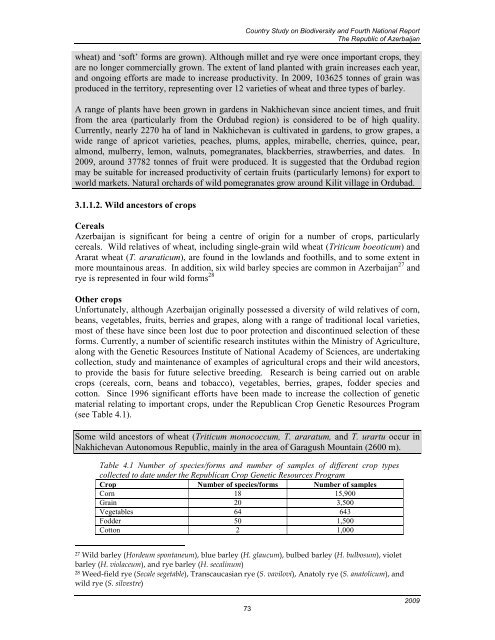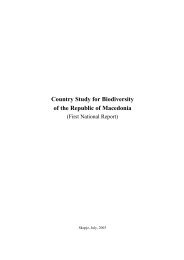CBD Fourth National Report - Azerbaijan (English version)
CBD Fourth National Report - Azerbaijan (English version)
CBD Fourth National Report - Azerbaijan (English version)
You also want an ePaper? Increase the reach of your titles
YUMPU automatically turns print PDFs into web optimized ePapers that Google loves.
Country Study on Biodiversity and <strong>Fourth</strong> <strong>National</strong> <strong>Report</strong><br />
The Republic of <strong>Azerbaijan</strong><br />
wheat) and ‘soft’ forms are grown). Although millet and rye were once important crops, they<br />
are no longer commercially grown. The extent of land planted with grain increases each year,<br />
and ongoing efforts are made to increase productivity. In 2009, 103625 tonnes of grain was<br />
produced in the territory, representing over 12 varieties of wheat and three types of barley.<br />
A range of plants have been grown in gardens in Nakhichevan since ancient times, and fruit<br />
from the area (particularly from the Ordubad region) is considered to be of high quality.<br />
Currently, nearly 2270 ha of land in Nakhichevan is cultivated in gardens, to grow grapes, a<br />
wide range of apricot varieties, peaches, plums, apples, mirabelle, cherries, quince, pear,<br />
almond, mulberry, lemon, walnuts, pomegranates, blackberries, strawberries, and dates. In<br />
2009, around 37782 tonnes of fruit were produced. It is suggested that the Ordubad region<br />
may be suitable for increased productivity of certain fruits (particularly lemons) for export to<br />
world markets. Natural orchards of wild pomegranates grow around Kilit village in Ordubad.<br />
3.1.1.2. Wild ancestors of crops<br />
Cereals<br />
<strong>Azerbaijan</strong> is significant for being a centre of origin for a number of crops, particularly<br />
cereals. Wild relatives of wheat, including single-grain wild wheat (Triticum boeoticum) and<br />
Ararat wheat (T. araraticum), are found in the lowlands and foothills, and to some extent in<br />
more mountainous areas. In addition, six wild barley species are common in <strong>Azerbaijan</strong> 27 and<br />
rye is represented in four wild forms 28<br />
Other crops<br />
Unfortunately, although <strong>Azerbaijan</strong> originally possessed a diversity of wild relatives of corn,<br />
beans, vegetables, fruits, berries and grapes, along with a range of traditional local varieties,<br />
most of these have since been lost due to poor protection and discontinued selection of these<br />
forms. Currently, a number of scientific research institutes within the Ministry of Agriculture,<br />
along with the Genetic Resources Institute of <strong>National</strong> Academy of Sciences, are undertaking<br />
collection, study and maintenance of examples of agricultural crops and their wild ancestors,<br />
to provide the basis for future selective breeding. Research is being carried out on arable<br />
crops (cereals, corn, beans and tobacco), vegetables, berries, grapes, fodder species and<br />
cotton. Since 1996 significant efforts have been made to increase the collection of genetic<br />
material relating to important crops, under the Republican Crop Genetic Resources Program<br />
(see Table 4.1).<br />
Some wild ancestors of wheat (Triticum monococcum, T. araratum, and T. urartu occur in<br />
Nakhichevan Autonomous Republic, mainly in the area of Garagush Mountain (2600 m).<br />
Table 4.1 Number of species/forms and number of samples of different crop types<br />
collected to date under the Republican Crop Genetic Resources Program<br />
Crop Number of species/forms Number of samples<br />
Corn 18 15,900<br />
Grain 20 3,500<br />
Vegetables 64 643<br />
Fodder 50 1,500<br />
Cotton 2 1,000<br />
27 Wild barley (Hordeum spontaneum), blue barley (H. glaucum), bulbed barley (H. bulbosum), violet<br />
barley (H. violaceum), and rye barley (H. secalinum)<br />
28 Weed-field rye (Secale segetable), Transcaucasian rye (S. vavilovi), Anatoly rye (S. anatolicum), and<br />
wild rye (S. silvestre)<br />
73<br />
2009

















